West Altadena was burning, and no one was there to save it.
More than 40 Los Angeles County fire trucks surrounded the Palisades fire, where an inferno was entering its 17th hour. An additional 64 fire trucks fanned out across east Altadena and neighboring areas, battling a blaze that had sparked in Eaton Canyon nine hours earlier.
But in west Altadena — where thousands of structures would burn and all but one of the 19 deaths from the Eaton fire would occur — there was just one county fire truck as the flames spread at 3:08 a.m. on Jan. 8, according to automatic vehicle locator data obtained by The Times.
Sofia Vidal holds a memorial tile of her tortoise, Ed, a 100-pound neighborhood fixture. She had to leave him behind as flames consumed her home. “He was scorched in the frontyard,” she said. “This was my baby.”
(Juliana Yamada/Los Angeles Times)
“We were abandoned,” said Sofia Vidal, 57, one of more than a dozen residents interviewed by The Times who said they stayed dousing flames through the night with no firefighters in sight. “I never heard a siren.”
Six months after the fire, the anger is palpable, with residents of the racially diverse unincorporated area, long a refuge for Black families, convinced that they suffered from weaker fire protection than whiter, wealthier areas near the Palisades fire.
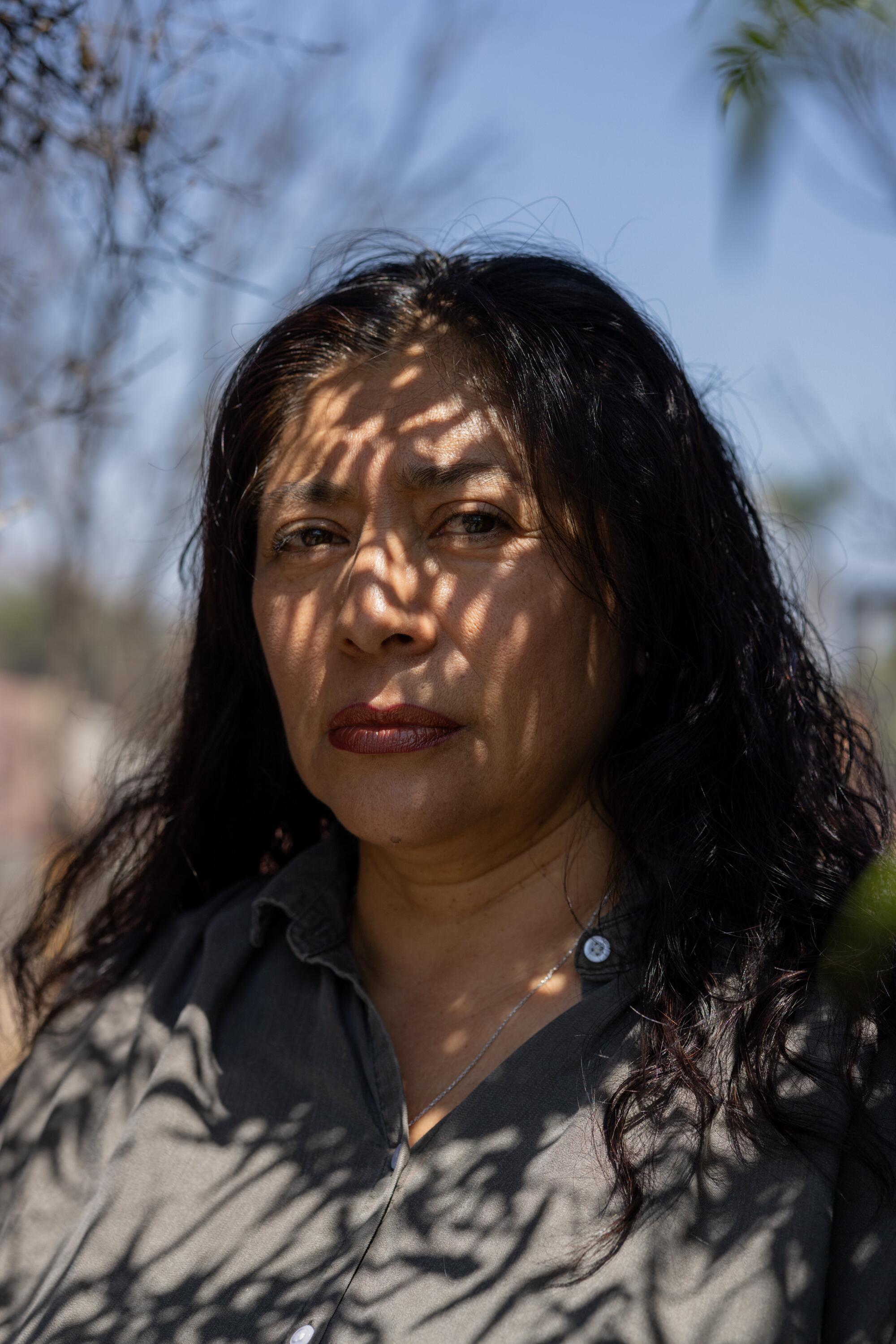
Sofia Vidal and her husband attempted to put out the flames at their home of 28 years as they waited for firefighters who never came.
(Juliana Yamada/Los Angeles Times)
The sense of neglect is so intense that nearly 1 in 5 residents believes the county Fire Department let the town burn on purpose, according to an Altadena-based public interest research firm that interviewed more than 1,200 residents.
“Am I grateful for firemen? Not at all,” said Vidal, who fled her home with her husband at 5:45 a.m. after burning squirrels began to fall from their palm tree. “Did they fail me miserably? Absolutely.”
The L.A. County Fire Department’s top brass has described the destruction in west Altadena as almost inevitable. The wind was too intense. The flames were too violent. The whole night, unprecedented.
But the vehicle locator data, which show that most county fire trucks didn’t shift into west Altadena until long after it was ravaged by fire, complicate the narrative. How much could have been saved, residents wonder, if firefighters focused on their neighborhood instead?
L.A. County Fire Chief Anthony Marrone said the lack of fire trucks in west Altadena probably boiled down to “human error” by fire officials who decided where the trucks should move. Those officials — from the county as well as other agencies — were part of the “unified incident command” stationed for most of the fire at the Rose Bowl in Pasadena.
“Why didn’t we do a better job of dividing resources between east and west Altadena, right? That’s a fair question,” Marrone said. “What was going on? What were the people doing?
“Did people who were working west not accurately communicate the dire circumstances that they were faced with?” said Marrone, who said he was at the Rose Bowl that night pleading with agencies across the region to send more trucks to the Eaton fire. “Or was there a lack of resources? Or were both sides of the fire equally challenging? … I don’t know which one of those it is. It’s probably a little bit of all of that.”
Marrone said it’s possible that other fire agencies sent vehicles to focus on west Altadena, but his department didn’t track their locations.
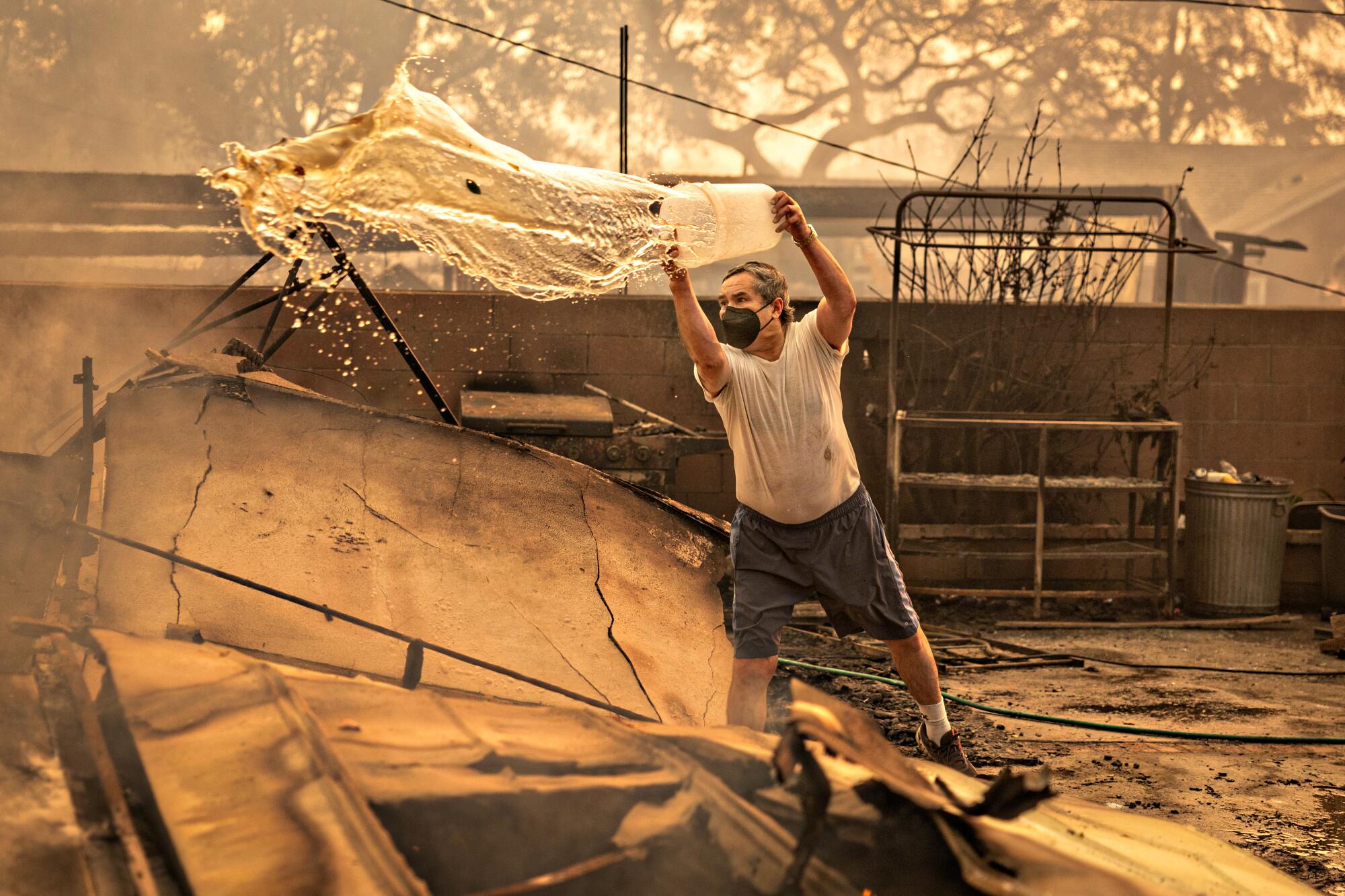
Juan Munoz pours water on the fire-ravaged remains of the home where he lived for over 39 years during the Eaton fire on Jan. 8 in Altadena.
(Jason Armond/Los Angeles Times)
The cascade of events leading to the tragedy in west Altadena began when the Los Angeles Fire Department failed to pre-deploy fire trucks to Pacific Palisades amid dire wind warnings, forcing the county to pitch in.
But west Altadena suffered from more than being the last place to catch fire in a day full of infernos. The vehicle locator data, according to some former L.A. city and county fire officials, point to a failure within the incident command coordinating the county’s response, led that night by Deputy Fire Chiefs Eleni Pappas and Albert Yanagisawa.
A growing fire is broken up into divisions, with supervisors — often battalion chiefs — communicating the fire conditions in their divisions up the chain to incident commanders, who use the information to decide where to position fire trucks.
Incident commanders, the former officials said, should pay attention to the “big picture” — not just where flames are raging, but where they’re headed. That means sending fire patrols — vehicles equipped with a pump, hose and water — to nearby neighborhoods to spot whether the fire has jumped with the wind. And it means quickly repositioning firefighters from the biggest eruption to small but growing ones, where they may have more impact.
Only one county fire patrol stopped west of Lake Avenue, the dividing line between east and west Altadena, during the first 12 hours of the Eaton fire, the vehicle locator data show, with assistant and battalion chiefs staying out of the heart of the neighborhood. Most county fire trucks didn’t move from the Eaton Canyon area, where the fire first erupted, until west Altadena was well on its way to burning to the ground.
Yanagisawa said incident commanders “did their very best” to battle a fire that dramatically outpaced their resources, with hurricane-force winds pushing the flames in different directions throughout the night.
But a former Los Angeles Fire Department incident commander said the data showed that too many firefighters were deployed like “moths to a candle,” directed to swarm the flames immediately in front of them.
“Nobody stood back and looked at the big picture,” said the official, who spoke on the condition of anonymity to discuss another agency’s operations. “It takes leadership and situational awareness to direct that as an incident commander and say, ‘Hey guys, I understand you guys are fighting fire there. I don’t need you there. Based on the map, weather, rate of fire spread and 911 calls we’re getting, I need you to defend homes and evacuation in this other community.’”
The automatic vehicle locator data, which The Times obtained through a public records request, track L.A. County Fire Department vehicles responding to the Palisades and Eaton fires on a minute-to-minute basis. The Times used the GPS coordinates to pinpoint every time a truck stopped.
Fire trucks from the roughly 20 other agencies responding to the Eaton fire, such as the U.S. Forest Service and the Pasadena Fire Department, were not captured in the data, nor were county trucks that didn’t have a vehicle locator system or whose system was not working. County officials said there could also be gaps in the data caused by disruptions in cell service. The Times has requested, but not received, vehicle locator data for some of the other agencies.

Firefighters extinguish hot spots at a home destroyed by the Eaton fire in Altadena on Jan. 11.
(Allen J. Schaben/Los Angeles Times)
The data provide a possible explanation for one of county officials’ key failures. Residents west of Lake Avenue did not get an evacuation order until 3:25 a.m. Jan. 8 — more than four hours after flames were first reported in the area. East Altadenans got their first evacuation order at 6:40 p.m. Jan 7.
Some former fire officials said the data suggest that firefighters may not have known of the embers flying into western neighborhoods. Ferocious winds grounded a county helicopter over Eaton Canyon almost immediately, leaving no bird’s-eye view. On the ground, county fire trucks were focused almost entirely east of Lake. No county fire vehicles responded to the 911 calls trickling in from west Altadena early in the night, according to the data, though it’s possible other agencies did.
The county has hired the consulting firm McChrystal Group to investigate what went awry with the evacuation orders. The county Sheriff’s Department and the county Fire Department, which both had first responders in Altadena that night, have said they shared responsibility for ordering evacuations. A spokesperson for the Sheriff’s Department did not respond to an inquiry about where deputy vehicles were that night, and the agency has not fulfilled a request for vehicle locator data.
While homes near the foothills around Eaton Canyon were mostly unscathed by flames, most of west Altadena was destroyed. Thousands of structures were lost. Eighteen people died there — the vast majority on blocks where a county fire truck never stopped. One additional victim perished just east of Lake Avenue.
On West Terrace Street, despite three 911 calls, no aid came for Anthony Mitchell Sr., a 68-year-old amputee, and his son, who had cerebral palsy.
On Monterosa Drive, Victor Shaw, 66, died fighting the flames with a garden hose after a neighbor called 911.
On Tonia Avenue, Erliene Kelley, 83, died after calling 911 twice.
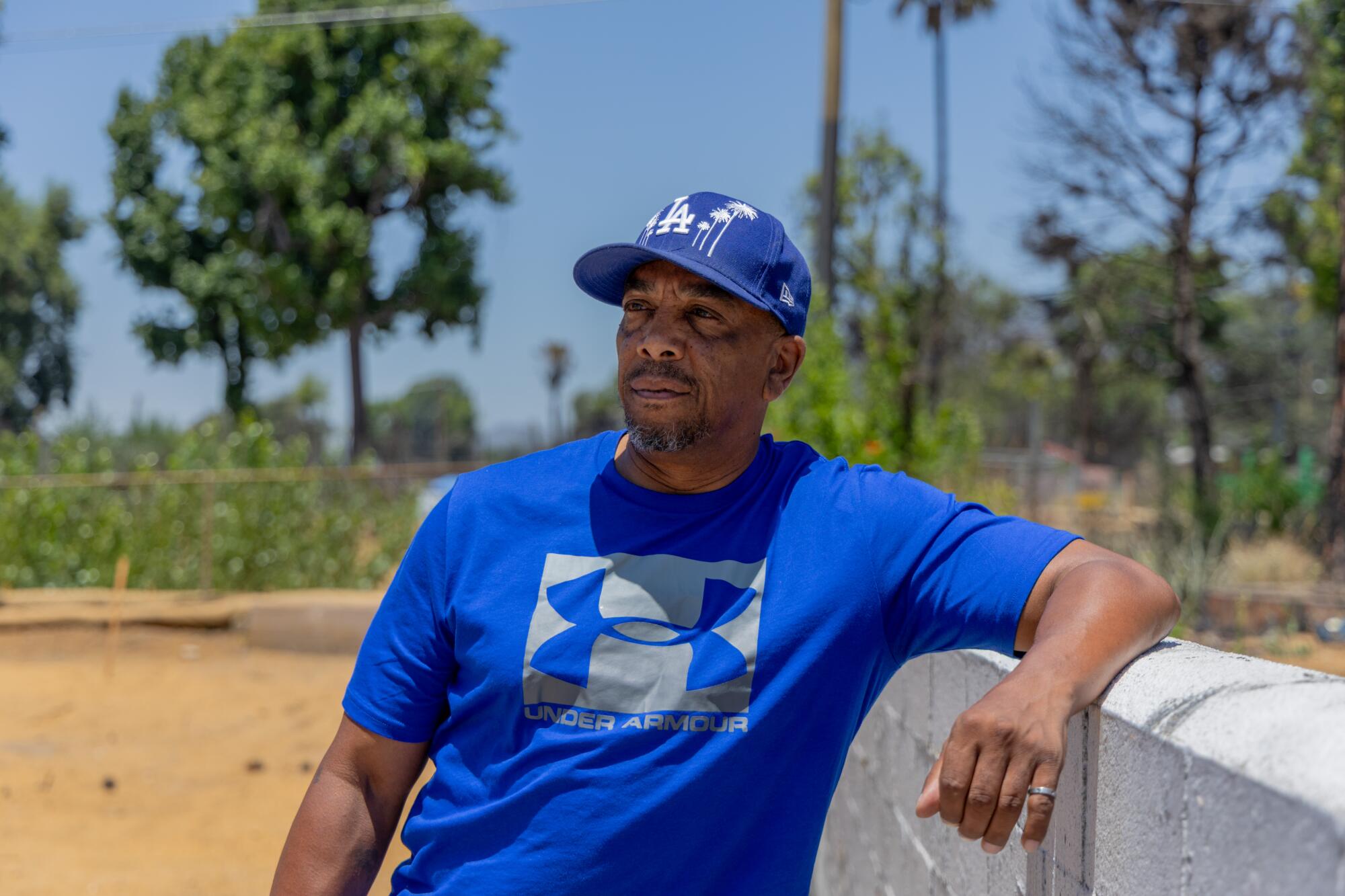
Trevor Kelley at the site of his childhood home in Altadena.
(Juliana Yamada/Los Angeles Times)
Her son, Trevor Kelley, tried to rescue her around 6 a.m., inching through oily black smoke too thick for his truck’s high beams to penetrate. He said he understood why no firefighters attempted it.
“The only reason why I went is because of my mom and pure adrenaline, but I can see that it would be impossible for them,” said Kelley, 59, who arrived to find his mother’s home burned to the ground. “They would actually be committing suicide.”
The county started the day with firefighters to spare.
Marrone, responsible for fire protection across unincorporated parts of L.A. County as well as roughly 60 cities, extended the shift of firefighters about to go home the morning of Jan. 7, leaving him with 1,800 on hand. Later in the evening, he ordered 50 strike teams from the state, bringing an additional 250 vehicles into the fray.
When sparks ignited near Pacific Palisades around 10:30 a.m., county fire trucks raced to help the Los Angeles Fire Department, which had been caught flat-footed after staffing a fraction of its available vehicles.
In a day full of failures, the city’s staffing decision, experts said, was the original sin, creating a “domino effect” that hamstrung the county’s response to fires in its own territory.
“They pretty much used up their extra people to assist L.A. city,” said Rick Crawford, a former LAFD battalion chief who reviewed The Times’ vehicle locator analysis.
By 6:15 p.m., according to the data, the county had sent 47 fire trucks and more than 40 other vehicles to the Palisades fire. More than one-third were in Pacific Palisades — an area the city Fire Department is responsible for.
With the fire still raging across the Santa Monica Mountains, those trucks stayed put when flames erupted in Eaton Canyon at 6:18 p.m., about 40 miles away.
New county fire trucks flooded the canyon area to fight what would become the most hellish blaze of the day, with hurricane-force winds scattering embers in every direction. Trucks soon moved into the eastern reaches of Altadena and small pockets of Pasadena before fanning east into Kinneloa Mesa, Sierra Madre and Pasadena’s Hasting Ranch neighborhood, the data show.
Firefighters said they met pure chaos on every corner — residents in wheelchairs desperate to escape nursing facilities, residents begging for their families to be saved. With lives still at risk, some county fire leaders said, it may not have made sense to divert to the west.
“We did not have enough people to shift in masses from one area of Altadena to another,” said Dave Gillotte, head of the county firefighters union. “The story very well could be, why did fire engines leave the area where we had people still trapped?”
A little after 10 p.m., some county fire trucks headed toward Sylmar after reports of a third fast-moving blaze came in from the San Fernando Valley.
“You can’t just say, ‘I’m not sending anybody to the Hurst fire — let it burn,’’’ Marrone said.
Marrone said he has not conducted an analysis of fire truck locations because the state has hired the Fire Safety Research Institute to do an independent review of the overall fire response.
He cautioned that the vehicle locator data show only a partial picture, because they don’t include dozens of trucks from other agencies. The California Governor’s Office of Emergency Services, for example, sent 68 fire trucks during the first 12 hours of the Eaton fire but did not have locator information available for them. The Pasadena Fire Department had 12 trucks at the Eaton fire that night, in addition to patrols, but couldn’t say how much time they spent in Altadena, according to Chief Chad Augustin.
The unified incident command was led that night by the county, along with the U.S. Forest Service, the L.A. County Sheriff’s Department and several other nearby fire agencies. Marrone said that with his firefighters overwhelmed in the east, other agencies that came on scene later should have helped in west Altadena.
“I don’t agree that it’s L.A. County’s responsibility to make sure we go into west Altadena,” he said. “I’m not going to allow L.A. County Fire or the men and women of my department to take this on the chin as, ‘Oh, the Eaton fire failure, the Eaton fire deaths, were solely the responsibility of Chief Marrone and his men and women.’ No, in my mind, that can’t be farther from the truth.”
As firefighters battled three raging blazes across the county on Jan. 7, 911 dispatchers got the first clear sign at 10:50 p.m. that flying embers were threatening homes west of Lake Avenue.
A 911 caller reported a flaming roof on East Calaveras Street. Two more calls from the street followed.
By 3:25 a.m., when the first evacuation order for the area went out, 911 dispatchers had received 17 reports of fire from homes west of Lake Avenue. No county fire trucks responded to those homes, according to the data.
“Where these calls come in, they’ve got to assign somebody right away. ‘Hey, yeah, we got reports of this fire jumping Lake Avenue. What’s going on? Any engines over there?’” said a former L.A. County fire captain who reviewed The Times’ analysis and requested anonymity to speak candidly about his former employer’s response. “We’re taught to not grow roots, so to speak, in any one area — you’ve got to move.”
Marrone said the addresses from the 911 calls should have all been relayed to the unified incident command. It’s possible, he said, that commanders sent fire trucks from other agencies to those calls, which wouldn’t have been reflected in the data.
Soon, west Altadena was a hellscape. Dispatchers were fielding a deluge of 911 calls, many from residents trapped inside burning homes.
“I begged them to come. I imagine they have me on tape — I was crying when I said it. My life was going before my eyes,” said Daniel MacPherson, 70, who called 911 around 5 a.m. after the smoke grew so thick he couldn’t see his hand. “They said, ‘We’re busy.’”
He escaped as his neighbors’ home was engulfed in flames. Kim Winiecki, 77, and Evelyn McClendon, 59, didn’t make it out.
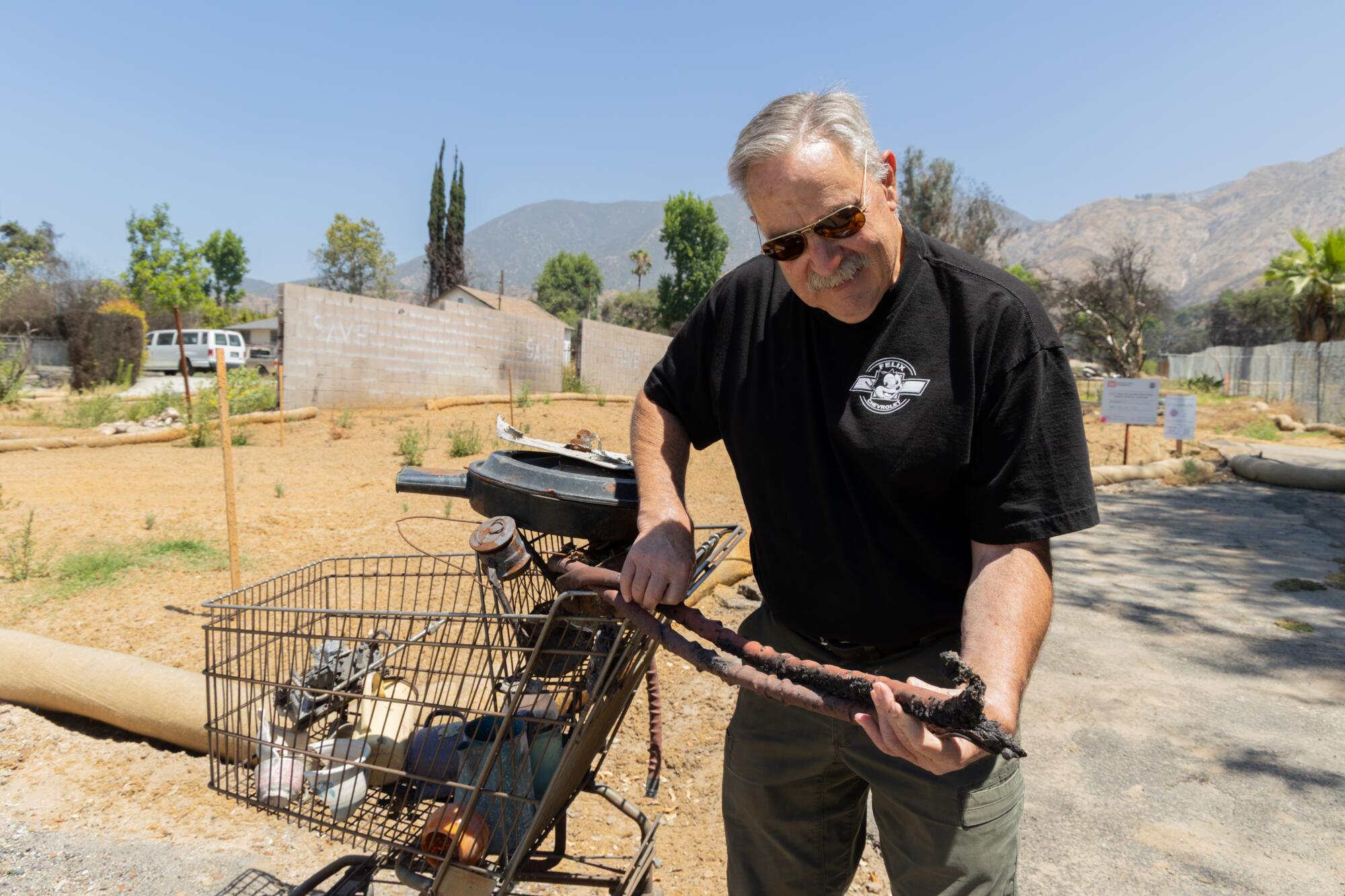
Daniel MacPherson holds a burned garden hose at the site of his former home on July 7 in Altadena. MacPherson, a lifelong Altadena resident, fought fire off of his property until he was forced to flee.
(Juliana Yamada/Los Angeles Times)
After the 3:25 a.m. evacuation order, some county fire trucks moved into west Altadena, but most stayed east, according to the vehicle locator data, even as the blaze worsened in the west. Between 5:30 and 6 a.m., 42 trucks made stops around the Eaton fire, but just seven of them in west Altadena.
The number of fire trucks in the area gradually increased through the afternoon, the data show, though homes continued to burn throughout the day.
Sylvie Andrews, 45, returned to her home around 11 a.m. after the winds had calmed — just in time to watch it go up in flames.

Lauren Martinez, left, Evan Chambers and Sylvie Andrews, who are working on an effort to sue the county for delayed evacuation warnings in west Altadena, stand in front of a sign labeling the destruction of the Eaton fire at Good Neighbor Bar in Altadena on June 2.
(Carlin Stiehl/Los Angeles Times)
“It was fightable, and they were not fighting at all,” said Andrews, who said she was sympathetic to the difficulty of saving homes at the fire’s peak but couldn’t understand why she lost everything later in the morning.
Many Altadena residents don’t need data to be convinced that their homes probably burned with no fire trucks around.
The marquee at a local Catholic school was vandalized to read: “FIRE DEPARTMENT WTF.” Neighbors joke about defending their street with a “bucket brigade.”
“Citizens with garden hoses — those are the only people who fought the fire,” said Steven Lamb, who said he spent the night pacing his street with his hose, battling flaming palm fronds and embers the size of baseballs.
Lamb, a residential designer, said sheriff’s deputies forced him to evacuate at 10:30 a.m. He turned on the news at 2 p.m. to see his house had burned to the ground.
At 67 years old, he’s now living with his wife in his childhood bedroom in his mother’s home.
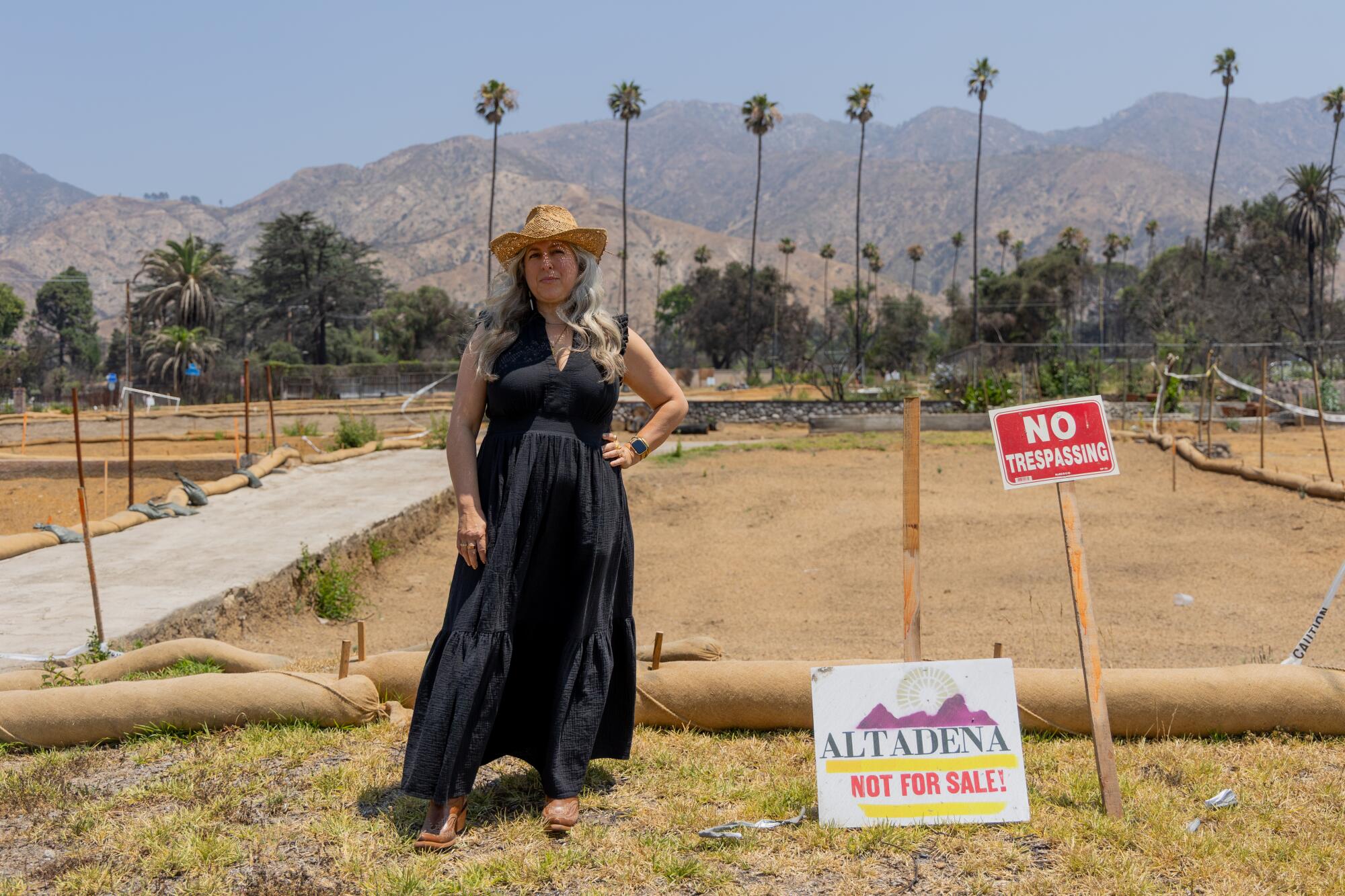
Shawna Dawson Beer stands on the remains of her former home on July 15 in Altadena. Dawson Beer and her husband lived there for 15 years before the Eaton fire destroyed their property.
(Juliana Yamada/Los Angeles Times)
Shawna Dawson Beer, who runs a popular Facebook group for Altadenans, described residents as in “pitchfork mode.”
“I did not think there was any universe where it would be possible to turn a community against beloved first responders — this is it,” said Dawson Beer, 51. “We were left to burn.”

















